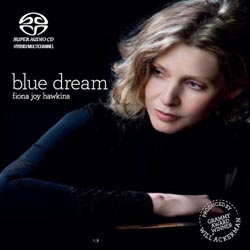 |
 |
|
Album Title: Blue Dream
Performer: Fiona Joy Hawkins, piano
Label: Little Hartley Music
Running time: 67'50"
Recorded: Imaginary Road Studios, Vermont - 2008
|
Where is the movie? That's the question which came to mind after a first listen of Blue Dream.
I am not a qualified New Age expert but is that really a problem with this genre? What kind of specific background could it require?
So many questions and so few answers.
The movie thus far has not been released and I will only write about the intrinsic artistic appeal of the music without trying to classify this record among the large collection of New Age recordings.
|
|
 |
|
Fiona Joy Hawkins is an Australian composer and pianist. Her style can be defined as mainly contemplative and this last outing is a 68-minute suite of piano music written by her.
The 22 tracks are organized in a very modern way to compile a single suite. The pianist develops an intimate climate with subtle interior landscapes which tend to overlap. In various pieces, certain exotics instruments support the pianist to focus upon a specific atmosphere. "Feeling Sunshine" for example reflects Hawkins' Australian heritage with the sound of Didjeribone, an adaptation of the traditional Didgeridoo. It is clearly one of the more energetic pieces and exudes fun and happiness.
|
I do not know exactly the particular cultural background of Fiona Joy Hawkins but beyond sensitive and ethereal phrasing, I found some parallels between her own dialogue and the minimalism of Philip Glass in The Hours and also with certain aspects of Pat Metheny’s poetry in the soundtrack A map of the world. Fiona Joy Hawkins does not deliver the Glass level of complexity so don't put the two albums in the same bag. But beyond the minimalist phrasing of the pianist, which is often inclined to sound more folk than contemporary, there is a true vision of a complete framework whose different parts blend flawlessly together. In fact Blue Dream sounds like a pretty good movie soundtrack, the kind that have been expressly written for films such as to become an intrinsic part of them.
The beauty of the Steinway B timbres were captured with accuracy by the engineering staff and the overall mood of Blue Dream is focused on contemplative pianism with alternate ethnic takes like the African "Samite's Interlude" that highlight the concept of world music.
Curiously,
I had a completely different assessment between headphones and loudspeakers. Headphone listening was not very compelling. In my opinion, Blue Dream requires natural ambience and a few times I was surprised by the depth from the keyboard and the amount of bass coming from my loudspeakers. |
|
|
The title track seems surprisingly recognizable as though Fiona approached such a level of listener intimacy that you immediately know what she has in mind. Hawkins is a beautiful soul and this transpires in how she plays music. Even if I like to stimulate my intellect with technical wizardry and virtuosity, I must recognize that I have been seduced listening to the simple, sensitive and haunting lyricism of Blue Dream. |
|
 |
|